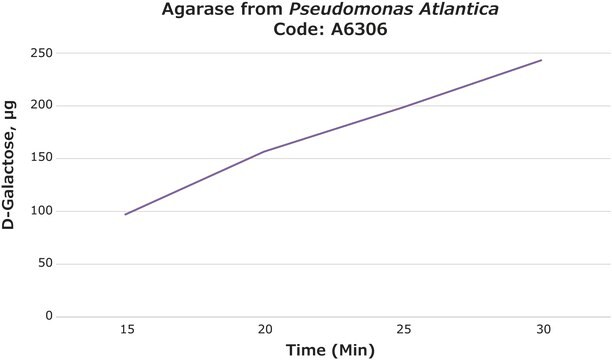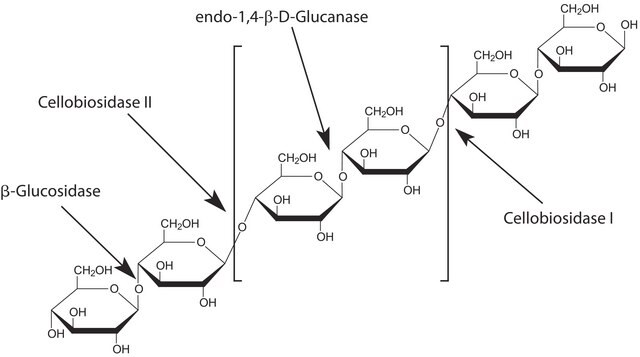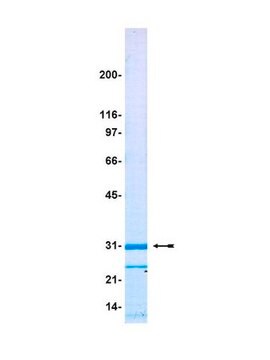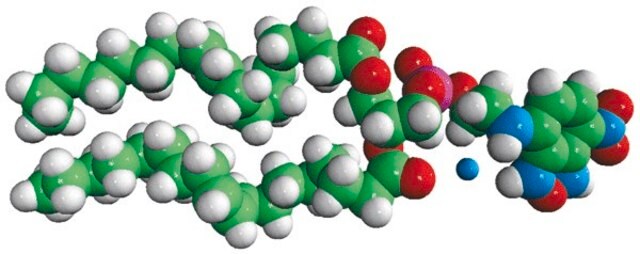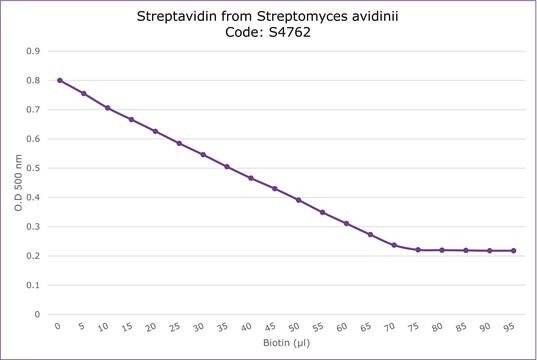F1010
Anti-Mouse Polyvalent Immunoglobulins (G,A,M)−FITC antibody produced in goat
affinity isolated antibody, buffered aqueous solution
Zaloguj sięWyświetlanie cen organizacyjnych i kontraktowych
About This Item
Polecane produkty
pochodzenie biologiczne
goat
białko sprzężone
FITC conjugate
forma przeciwciała
affinity isolated antibody
rodzaj przeciwciała
secondary antibodies
klon
polyclonal
Formularz
buffered aqueous solution
metody
direct immunofluorescence: 1:256
temp. przechowywania
2-8°C
docelowa modyfikacja potranslacyjna
unmodified
Opis ogólny
Immunoglobuliny to białka wytwarzane przez komórki B w odpowiedzi na antygen i regulujące odpowiedź na bakterie i wirusy. IgG jest głównym typem przeciwciał występującym w osoczu i płynie pozakomórkowym i odgrywa kluczową rolę w wiązaniu dopełniacza i transporcie łożyskowym. IgA odgrywa kluczową rolę w odporności błon śluzowych, ponieważ ogranicza przedostawanie się patogenów do błony śluzowej. IgM jest największym przeciwciałem o strukturze pentamerycznej, która reguluje polireaktywność i usuwa komórki apoptotyczne. Przeciwciało przeciw poliwalentnym immunoglobulinom mysim (G,A,M)-FITC może być stosowane w immunofluorescencji bezpośredniej i immunoelektroforezie. Kozie przeciwciało przeciw mysim immunoglobulinom wielowartościowym (G,A,M)-FITC reaguje specyficznie z mysimi IgG, IgA lub IgM.
Immunogen
Oczyszczone mysie IgG, IgA i IgM
Zastosowanie
Przeciwciało przeciw poliwalentnym immunoglobulinom mysim (G,A,M)-FITC może być stosowane w immunohistochemii i cytometrii przepływowej.
Zastosowania, w których z powodzeniem wykorzystano to przeciwciało, oraz związane z nimi recenzowane artykuły, podano poniżej.
Immunofluorescencja (1 artykuł)
Immunofluorescencja (1 artykuł)
Postać fizyczna
Roztwór w 0,01 M soli fizjologicznej buforowanej fosforanami, pH 7,4, zawierający 1% albuminy surowicy bydlęcej i 15 mM azydku sodu.
Oświadczenie o zrzeczeniu się odpowiedzialności
O ile nie określono inaczej w naszym katalogu lub innej dokumentacji firmy dołączonej do produktu(-ów), nasze produkty są przeznaczone wyłącznie do użytku badawczego i nie mogą być wykorzystywane do żadnych innych celów, w tym między innymi do nieautoryzowanych zastosowań komercyjnych, zastosowań diagnostycznych in vitro, zastosowań terapeutycznych ex vivo lub in vivo lub jakiegokolwiek rodzaju konsumpcji lub zastosowania u ludzi lub zwierząt.
Ta strona może zawierać tekst przetłumaczony maszynowo.
Nie możesz znaleźć właściwego produktu?
Wypróbuj nasz Narzędzie selektora produktów.
Kod klasy składowania
10 - Combustible liquids
Klasa zagrożenia wodnego (WGK)
WGK 2
Temperatura zapłonu (°F)
Not applicable
Temperatura zapłonu (°C)
Not applicable
Wybierz jedną z najnowszych wersji:
Masz już ten produkt?
Dokumenty związane z niedawno zakupionymi produktami zostały zamieszczone w Bibliotece dokumentów.
A C Cunningham et al.
Immunology, 86(2), 279-286 (1995-10-01)
The role of major histocompatibility complex (MHC) and adhesion molecule expression by alveolar epithelium on the modulation of immune responses in the lung is not understood. We have developed efficient methods to isolate, purify and culture human alveolar epithelial cells
Daniel Růzek et al.
Virus research, 137(1), 142-146 (2008-07-08)
We undertook a comparative study of the susceptibility of different tick cell lines to infection with the European subtype of tick-borne encephalitis virus (TBEV), prototype strain Neudoerfl. The growth of TBEV was investigated in lines derived from vector Ixodes ricinus
A Gonzalez-Ruiz et al.
Journal of clinical microbiology, 30(11), 2807-2813 (1992-11-01)
Approximately 10% of the world population is infected with Entamoeba histolytica, but only 10% of the carriers develop symptomatic amebiasis. This discrepancy could be explained by the genotypic differences between the morphologically indistinguishable invasive and noninvasive strains of E. histolytica
S P Wang et al.
Journal of clinical microbiology, 29(7), 1295-1298 (1991-07-01)
A new method for determining the serovars of Chlamydia trachomatis isolates by utilizing fluorescent-antibody staining of inclusions in cell culture is described. Monoclonal antibodies which have been successfully used previously for serotyping in the microimmunofluorescence test were employed. The cell
María Mónica Remedi et al.
International journal of experimental pathology, 90(1), 44-51 (2009-02-10)
The tumour microenvironment, which is largely composed of inflammatory cells, is a crucial participant in the neoplastic process through the promotion of cell proliferation, survival and migration. Neutrophil polymorphonuclear cells (PMNs) induce inflammatory reactions that can be either cytotoxic for
Nasz zespół naukowców ma doświadczenie we wszystkich obszarach badań, w tym w naukach przyrodniczych, materiałoznawstwie, syntezie chemicznej, chromatografii, analityce i wielu innych dziedzinach.
Skontaktuj się z zespołem ds. pomocy technicznej